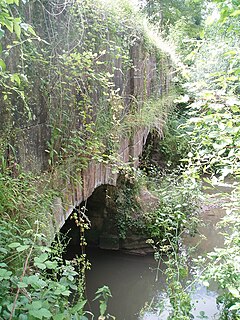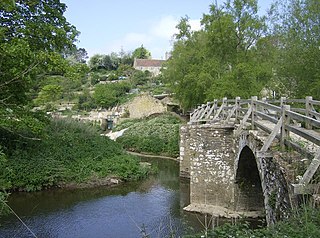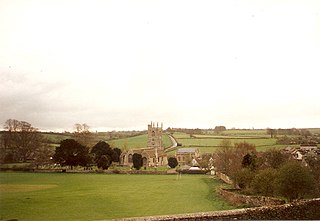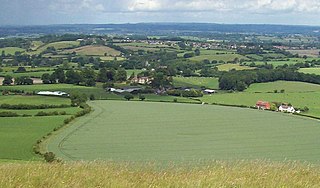Cheap Street may refer to:
- Cheap Street, Bath, a historic street in Bath, England
- Cheap Street, Frome, a historic street in Frome, England
- Cheap Street Press, a defunct American publishing company
Cheap Street may refer to:

The Dorset and Somerset Canal was a proposed canal in southwestern England. The main line was intended to link Poole, Dorset with the Kennet and Avon Canal near Bradford on Avon, Wiltshire. A branch was to go from the main line at Frome to the southern reaches of the Somerset coalfield at Nettlebridge. Construction of the branch started in 1786, using boat lifts rather than locks to cope with changes of level, but the company ran out of money and the canal was abandoned in 1803, never to be completed.

Frome is a town and civil parish in eastern Somerset, England. The town is built on uneven high ground at the eastern end of the Mendip Hills, and centres on the River Frome. The town, about 13 miles (21 km) south of Bath, is the largest in the Mendip district of Somerset and is part of the parliamentary constituency of Somerton and Frome.

Warminster is an ancient market town with a nearby garrison, and civil parish in south west Wiltshire, England, on the western edge of Salisbury Plain. It has a population of about 17,000. The 11th-century Minster Church of St Denys stands near the Were, which runs through the town and can be seen running through the town park. The name Warminster first occurs in the early 10th century. The High Street and Market Place have many fine buildings; The Athenaeum Centre, Town Hall, St Lawrence Chapel, The Old Bell, and a good variety of independent shops.

Buckland Dinham is a small village near Frome in Somerset, England. The village has a population of 381. The village's main industry is farming, but the village is also a dormitory village for the nearby cities of Bath and Bristol.

The River Frome is a river in Somerset, England. It rises near Bungalow Farm on Cannwood Lane, south-west of Witham Friary, flows north through Blatchbridge to the town of Frome, and continues in a generally northerly direction passing between the eastern edge of the Mendip Hills and Trowbridge before joining the Bristol Avon at Freshford, below Bradford on Avon.

Whatley is a small rural village and civil parish about 2.5 miles (4 km) west of Frome in the English county of Somerset. The parish lies south of Mells and north of Nunney, and includes the hamlets of Lower Whatley and Chantry.

Beckington is a village and civil parish in the Mendip district of Somerset, England, across the River Frome from Lullington about three miles north of Frome. According to the 2011 census the parish, which includes the hamlet of Rudge, which has a population of 983, and the hamlet of Standerwick.

Rode is a village in the ceremonial county of Somerset in England, 5 miles (8.0 km) northeast of Frome and 5 miles (8.0 km) southwest of Trowbridge.

Norton St Philip is a village and civil parish in the Mendip district of Somerset, England. The village lies about 5+1⁄2 miles (9 km) south of the city of Bath and 5 miles (8 km) north of the town of Frome on the eastern slopes of the Mendip Hills. It is situated on the A366 between Trowbridge and Radstock, and on the B3110 between Bath and Frome.

Corsley is a hamlet and civil parish 3 miles (5 km) west of Warminster in Wiltshire, England. The parish is on the county border with Somerset; the Somerset town of Frome is about 3 miles (5 km) to the northwest. The largest settlement in the parish is Corsley Heath, which is on the A362 Warminster-Frome road.

Hemington is a village and civil parish 5.5 miles (8.9 km) north west of Frome, in the Mendip district of Somerset, England. It is located just off the A366 between Trowbridge and Radstock. The parish includes the villages of Hardington, Faulkland and Foxcote.

Lullington is a village and civil parish just across the Mells River from Beckington and 2.5 miles (4.0 km) north east of Frome, in the Mendip district of Somerset, England.

Frome railway station serves a largely rural area of the county of Somerset in England, and is situated in the town of Frome. The station is located on a 1.5 miles (2.4 km) long branch line which loops off the main line railway, which carries services on both the Reading to Taunton line and Bristol to Weymouth route. Most of the trains which take the loop line in order to serve Frome station are on the Bristol to Weymouth route, and most trains on the Reading to Taunton line by-pass the station on the main line. The station is 22.25 miles (36 km) south of Bath Spa on the Bristol to Weymouth line, it is owned by Network Rail and is operated by Great Western Railway.

The Church of St John the Baptist, Frome is a parish church in the Church of England located in Frome within the English county of Somerset. It is a Grade II* listed building.

St Jude's is a mixed residential, commercial and light industrial area of central Bristol, England. St Jude's forms part of the Lawrence Hill ward of Bristol City Council.

The Anglican Christ Church in Frome, Somerset, England, was built in 1817 and 1818. It is a Grade II* listed building.
Edward Cockey (1781–1860) was an industrial entrepreneur in Frome, Somerset, England, descended from a local family of metalworkers.
Thomas Bunn (1767-1853), gentleman and philanthropist, was a man of independent means who devoted his energies to improving his native town of Frome. His epitaph in Christ Church aptly sums up his life:
The Sheppard family dominated cloth manufacture in Frome, Somerset, England. They were the first to introduce machinery into the area and in the first quarter of the 19th century were the largest employers.
Emma Sheppard (1813–1871) was an English writer and workhouse reformer in Frome, who became widely known for her book Sunshine in the Workhouse and for efforts, both local and national, to improve conditions for inmates.